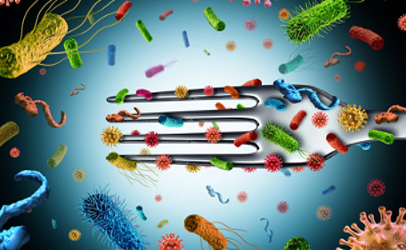 Every year more than 400,000 people in America get sick from infections caused by antibiotic-resistant foodborne bacteria, which cause more serious illnesses than other pathogens found in food.
Every year more than 400,000 people in America get sick from infections caused by antibiotic-resistant foodborne bacteria, which cause more serious illnesses than other pathogens found in food.
People infected by antibiotic-resistant foodborne bacteria can develop symptoms that are harder treat and more severe, leading to more hospitalizations and deaths than non-resistent pathogens, according to a recent report from the Centers for Disease Control and Prevention about antiobiotic resistance, food and food-producing animals.
“Antibiotic resistance is the ability of bacteria to resist the effects of an antibiotic. This means that bacteria are not killed by the antibiotic and can continue to grow,” according to the CDC report.
Bacteria like Salmonella and Campylobacter, from food and animals, cause about one in five resistant infections. If antibiotic use can be improved, the development of antibiotic-resistant bacteria should be slowed.
Antibiotics are used to treat serious bacterial infections in people. When these drugs are given unnecessarily to people or animals, bacteria can become resistant to the antibiotics. Prescribers should only treat people and animals with antibiotics when they need them for medically sound reasons, according to the CDC report.
“All humans and animals have bacteria in their gut. When they are given antibiotics, many of these bacteria are killed, but the resistant ones may survive and multiply. This is why the responsible use of antibiotics is so important in both humans and animals,” the CDC reported.
Specifically relating to food production, during the slaughtering and processing of animals for food, bacteria from animals’ intestines can contaminate meat and other food products. Animal feces can also spread bacteria to the surrounding environment, contaminating soil and water used to grow fruits and vegetables.
When humans eat contaminated produce, or raw or undercooked meat that has been contaminated with resistant bacteria, they can develop resistant infections.
“They can also get sick from contact with animal poop, either through contact with animals and animal environments, or through contaminated drinking or swimming water,” according to the CDC report.

CDC action plan
Public health agencies at the local and state levels help the CDC with its work to prevent infections caused by foodborne antibiotic-resistant bacteria, which includes:
- Tracking resistant infections and studying how resistance emerges and spreads;
- Detecting and investigating antibiotic-resistant outbreaks quickly to solve, stop, and prevent them;
- Determining the sources of antibiotic-resistant infections that are commonly spread through food and animals;
- Strengthening the ability of state and local health departments to detect, respond to, and report antibiotic-resistant infections;
- Educating consumers and food workers on prevention methods, including safe food handling, safe contact with animals, and proper hand washing; and
- Promoting the responsible use of antibiotics in humans and animals.
Consumers can help
The general public can help with the efforts to combat foodborne antibiotic-resistant infections by observing simple food safety practices, the CDC reported. Those practices include:
- Taking antibiotics only when needed;
- Using a food thermometer to ensure that foods are cooked to a safe internal temperature: 145°F for whole beef, pork, lamb, and veal (allowing the meat to rest for 3 minutes before carving or consuming), 160°F for ground meats, and 165°F for all poultry, including ground chicken and ground;
- Washing your hands after touching raw meat, poultry, and seafood. Also wash your work surfaces, cutting boards, utensils, and grill before and after cooking;
- Keeping your refrigerator below 40°F and refrigerate foods within 2 hours of cooking (1 hour during the summer heat);
- Separating raw meat, poultry, seafood and eggs from fresh produce and ready-to-eat foods to avoid cross contamination. Use different cutting boards to prepare raw meat or poultry and any food that will be eaten without cooking;
- Wash your hands after contact with poop, animals or animal environments;
- Report suspected outbreaks of illness from food to your local health department; and
- Review CDC’s Traveler’s Health recommendations when preparing to travel to a foreign country.
(To sign up for a free subscription to Food Safety News, click here.)
